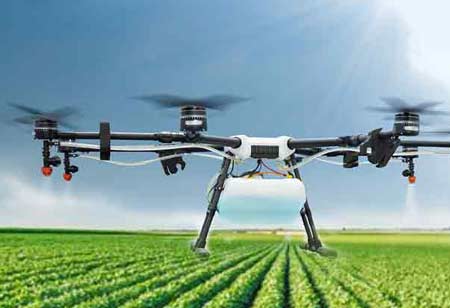Thank you for Subscribing to Agri Business Review Weekly Brief
Breaking the Digital Frontier in Agriculture with Mobile Apps
Based on applications, mobile application development for farming can contrive the following types of solutions

By
Agri Business Review | Wednesday, August 17, 2022
Stay ahead of the industry with exclusive feature stories on the top companies, expert insights and the latest news delivered straight to your inbox. Subscribe today.
As the soil conditions range from one place to another, altering information flows can advantage everyone.
FREMONT, CA: Based on applications, mobile application development for farming can contrive the following types of solutions:
Peer-to-Peer Information Sharing: Mobile app development can be guided to create information-sharing groups for a close-knit community of farmers. As the soil conditions range from one place to another, altering information flows can advantage everyone.
Online Lending for Farmers: An app could be agrarian cum financial in nature, where not only information but financial support in the form of loans could be expended. It could even assemble an e-commerce marketplace where access to inputs such as seeds, fertilizers, pesticides, and on-demand labor is provided.
B2B Farming Store: Offering an auctioning platform where food producers could get justified prices is greatly opportunistic. Given you have a strong network of farmers subscribed to the platform, food-procuring businesses could save critical time and energy by submitting bids and winning the auction while offering farmers handsome prices.
Weather Forecasting App:Numerous open sources for weather information utilize government satellite data and the publicly available history of geographic records to forecast changes. You can take this a step up. The in-built gyroscope & barometer in mobile devices can be utilized to gather the information that helps weather forecasting.
GPS Tracking: The human eye can hardly perceive the variance in ground levels and assumes the landscape is naturally flat. Studying top-soil conditions is impossible once the crop foliage grows beyond a certain extent. GPS trackers can lead farmers to target specific parts for leveling. Geo-fencing can study a chosen region of crops and share key performance indicators to optimize yields. Tech can also be used to plow furrows precisely.
Livestock Management Apps: Custom application development is tailored for livestock farms. The software can be utilized to register, process, and suggest the scope of advancement at every operation step. Farms can be categorized as per their business model, which ranges from breeding, feedlots, and dairies to industrial meat processors. Such apps can digitalize farm management chores and save big monies.
Reasonable Features of Farming Apps: According to the above classification, we can surmise a list of features traditionally suited to farming apps. Please note this is just an indicated checklist and not a set-in-stone word.
Drone Synchronization: The commercial drone segment packs a punch with promises of heavy returns. In the US alone, agriculture stakes claim a considerable allocation of drone installations. Drones or unmanned aerial vehicles unfold many scopes for automation and time consumption. They can be employed for field vigilance, precision spraying, and pest detection.
Mounting them with thermal cameras can even support farmers assess water spillage or exorbitant damping from drip irrigation. Drone sync and remote control with apps would certainly be a feature much wanted/appreciated by farmers.
In-App Chat: Chatbots – where human answers or machine answers contribute considerably to a business growth story. It is a basic app feature that targets establishing a two-way line with the customers. Be it local farming networks or consultative services.
A chat window would support farmers to open debate pressing issues or report new findings about anything farming. If not human-assisted, answers could be pre-fed to the app with the free-mium app model offering expert interaction on a pay-as-you-go basis.
Machine Vision & Cloud Storage Support :That plain old video conferencing isn’t captivating at all. Anybody with a Google Duo, WhatsApp, or Skype Mobile could video call for free. Real-time image processing and machine learning will take this feature to the platinum standard. Software developers indicate it as machine vision.
Farmers should be capable of uploading images, processing which the AI-powered backend could denote an imminent pest invasion still not sufficiently mature to surface. The inexperienced farmer could put the crops under a scanner (literally) and take essential measures to salvage what is left of them.
Informational Guides: As the profit margins are insufficient for most farmers, it is not a surprise that they are averse to informal experimentation with their choice of crops. But when they give in to temptation, wouldn’t it be convenient to have a ready-to-apply comprehensive guide for distinct crops? Consecrating a section of your farming app to good-to-know information will immensely advantage first-time growers of a crop.
More significantly, if they reap handsome profits, they will attract organic attention from others vis-a-vis word-of-mouth referrals. If you can list high-rated agricultural products, trusted distributors, and their contact information, then all the better.
Payment Gateway: he last characteristic could work best for a directory, but what if you plan to establish a full-fledged ecommerce application? In that case, you would have to allow the app to process payments through a gateway.
Weather Forecasts:Earlier, we noted an app to help farmers judge the weather and its mechanism. If not an independent application, you can still integrate it as a side feature of a larger app. Although you would have to engage an app development agency to achieve an all-inclusive mobile app with peripheral features that impact big farming time, the effort would be worth it.
Rounding Off :As a multi-award-winning mobile app development company, we at Appinventiv understand our social responsibility and agree that some things are better viewed from a moral compass. Yes, our duty to our stakeholders comes first, wherein we remain to do ground-breaking work in appearing technologies to this day.





